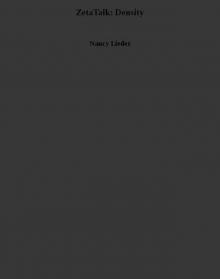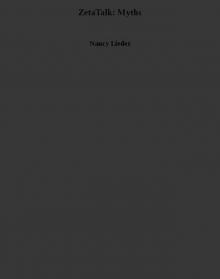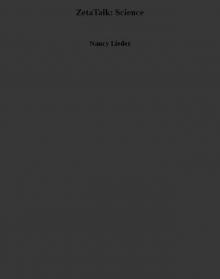- Home
- Nancy Lieder
ZetaTalk: Worlds Page 3
ZetaTalk: Worlds Read online
Page 3
and I took and shook one of the claws.
I asked about technology, and didn't get anything back. He did not come for this visit on his own power. I asked
about housing and got a telepathic scene of Bean Bag Man sort of flowing along the ground toward a sheltered
place along an embankment. Saying goodby, Bean Bag Man moved away from me, flowing along by heaving
parts of his body forward or backward along the ground. Bean Bag Man was all green, except for his bottom
where he abutted the ground, and this was black. A pleasant fellow, meaning me no harm.
Cockroach Man
Cockroach Man emerged from a blue/green pool, where he had been floating face down. The pool appeared to
be thick with algae. His back was smooth and rounded like a turtle shell, with no sign of wings, and he was gray
all over. He stood erect on a rear set of legs, looking like a giant cockroach on the front with several sets of
leg/arms ending in two toe/fingers and with a couple of round eyes at the head. He was not particularly
communicative.
http://www.zetatalk2.com/worlds/w15.htm[2/5/2012 11:34:30 AM]
ZetaTalk: Variety of Life Forms
Amoebae Man
Amoebae Man was light green and without form or distinction. He had no markings. He was on the floor, and
flowed parts of itself around my ankles so communication could occur. A picture of a rocky world where life
only occurs in the crevices was relayed to me. Amoebae man had to lay low to survive.
Vampire Man
Vampire Man looked like a hominoid flea. He stood 4 foot high with stubby little legs and arms and gray
leathery skin. The outstanding feature was 2 long, gray tusks coming down from his face about 4 inches apart.
My understanding was that this was the equivalent of our vultures, in that it eats the dead by sucking fluids from
a corpse. He seemed negative to me in that he wanted to intimidate, but like most bullies backed away when
really confronted. I grabbed a tusk and flipped him onto his back. Not being agile, it took him some minutes to
right himself, his stubby arms and legs flailing.
Dino Man
Dino Man looked like a small Tyrannosaurus Rex, but was no taller than a large man. He was dark green, with a
ridge down his back, and stood erect while leaning back on a large fat tail used for balance. The end of his tail
had a couple of pointed yellow barbs, which looked fluid filled and puffy. The mouth was lined with many teeth.
He was not a telepathic conversationalist except to insist that I was to obey him, a command he repeated several
times. When this was refused he opened his mouth to show all his teeth, leaning toward me. When he found he
could not intimidate me, he lost interest and turned his back.
End Nancy's Recall
All rights reserved: [email protected]
http://www.zetatalk2.com/worlds/w15.htm[2/5/2012 11:34:30 AM]
ZetaTalk: Size and Shape
Mail this Pageto a Friend.
ZetaTalk: Size and Shape
Note: written Aug 15, 1996. Planet X and the 12th Planet are one and the same.
Where intelligent life forms come from all possible stops on the evolution scale, they are fairly consistent in size. The reason for this rule is simple - on the inevitable encounters, intimidation would be minimized. Thus whether a life
form is similar to an insect, fish, octopus, snake, lizard, monkey, bird, or hominoid they have all been genetically engineered to be of the same approximate size.
Within these parameters there is great variation on other facets, however, as the life form must live on the world they evolved on, and this cannot be ignored. Thus, on those worlds where the mass of the planet is such that gravity exerts a great pull, the life form will evolve with enough strength in bone and muscle to move about. Thus the giant hominoids from the 12th Planet are large, heavy boned, and strong in comparison to humans, as their planet exerts almost twice as much gravity pull as the Earth. Thus we, the Zetas, are stronger than humans as our planets also had more mass and resulting gravity pull. Where skinny, our bones are bolstered by wrap around ribs and joints that move in fewer
directions than human joints, thus preventing strain.
The evolution of a life form and the home planet determines to some degree where the life form can travel and work.
Beyond the obvious differences in ability to tolerate high radiation from a hot sun or the need to breath air or water or the base chemistry of the DNA, there are issues of gravity tolerance. We, the Zetas who have chosen work on the
Earth's Transformation, cannot return to our home planets because the gravity would crush us. We have adapted to our new environments. Likewise it is known to your scientists that long space voyages without the semblance of Earth's
gravitational field would doom your astronauts to a lifetime in space.
Beyond approximate size, the life form may be carnivorous or vegetarian or if the planet is lush with watery nutrients even simply absorb nutrients through the skin as many single cell organisms do. They may have teeth or no teeth, eyes or no eyes or multiple eyes, skin that is dry and tough or covered with slim or oil, bones as an interior or exterior skeleton or no bones at all, able to generate their own sugars as do plants or be completely dependent upon food
located and eaten, breathing through lungs or gills or absorbing air or water components through the skin, covered with feathers or fur or scales or without an outer garment. Life forms come in all shapes, and humans embracing the
Awakening should be mentally and emotionally prepared to encounter them. Bear in mind that they think of the human
form as strange, too.
All rights reserved: [email protected]
http://www.zetatalk2.com/worlds/w58.htm[2/5/2012 11:34:31 AM]
ZetaTalk: The Vedas
Mail this Pageto a Friend.
ZetaTalk: The Vedas
Note: written May 15, 1996.
Ancient lore originating from the Persian Gulf describes with great accuracy interchanges that occurred between
humans and aliens and humans and the giant hominoids from the 12th Planet. This part of the world was literally
flooded with aliens from both the Service-to-Self and Service-to-Other orientations at times, due to the interference with the Earth's balance that the large and aggressive giant hominoids were causing. Those in the Service-to-Self came to promote this imbalance, which was leaning toward their orientation due to the fear and helplessness enslaved
humans were experiencing, and those in the Service- to-Other came to counter this trend. These battles eventually
resulted in the quarantine that was imposed by the Council of Worlds on the giant hominoids, who then left Earth.
During these battles aliens in the Service-to-Self and Service-to-Other orientation were engaged in a series of limited engagements that in some cases included the potential for death or injury to the physical form these spirits were
incarnated into. To the humans watching this drama it seemed magical, fantastic, and much like contactees today, they felt their stories unlikely to be believed. However, they energetically recorded everything they saw and heard, as unlike contactees of today they were allowed to record these memories in their conscious. All visitations or chance encounters prior to the Roswell crash were conscious, as the Earth had not yet formally voted on her future
orientation, her Transformation target orientation. Thus the Vedas record the classic battle between the Service-to-Self and Service-to-Others, intelligent life forms of every shape and size, and various antigravity phenomena such as
levitation and hovering craft. All real, and the tale is as fascinating to humans today as it was in the past.
All rights reserved: [email protected]
http://www.zetatalk2.com/worlds/
w50.htm[2/5/2012 11:34:31 AM]
ZetaTalk: Skyfish and Rods
Mail this Pageto a Friend.
ZetaTalk: Skyfish and Rods
written Oct 22, 2006
I've just read first time about "skyfish" here
http://www.membrana.ru/ Sorry, it's in russian, but you can
see pictures of these creatures. Does they really exist? [and
from another] I found an English site:
http://paranormal.about.com/
We have mentioned that mankind only is aware of approximately
1/1000 of the subatomic particles that we, the Zetas, are aware of.
Many atoms form crystals, a fact mankind is aware of because he
has discovered diamonds and other crystals formed in nature. These
are crystaline structures that have, from mankind's standpoint, a permanent structure. They last. Crystals that are ephemeral are not so well known. What mankind is discovering in rods and skyfish are these ephemeral crystals.
http://www.zetatalk2.com/index/zeta332.htm[2/5/2012 11:34:32 AM]
ZetaTalk: Galactic Zoos
Mail this Pageto a Friend.
ZetaTalk: Galactic Zoos
Note: written by Jul 15, 1995.
Regarding zoos, whether the Zetas have assembled zoos of terrestrial animals and plants on our own or other worlds.
We have not sought to do this, nor would there be any purpose to such an activity. We came in contact with other
worlds after we were granted the right to travel to these worlds. Since we have means to protect ourselves, we can
insert ourselves into the natural habitat, as you say. Any zoologist will tell you that this is preferable, from a study point of view. In addition, it is not humane to imprison life, sentient and intelligent or otherwise. This has never come up for discussion, and none of our number has ever proposed this.
All rights reserved: [email protected]
http://www.zetatalk2.com/worlds/w01.htm[2/5/2012 11:34:32 AM]
ZetaTalk: Genetic Contributions
Mail this Pageto a Friend.
ZetaTalk: Genetic Contributions
Note: written by Jul 15, 1995. Planet X and the 12th Planet are one and the same.
The Nordics and Pleiadeans are considered human in appearance, but in fact it is the humans who are Nordic and
Pleidean in appearance, as they came first! The Nordics did indeed contribute to mankind's genetic background, as did the Pleiadeans and many, many other alien races. The race we refer to as the Gods of Mount Olympus, and some input
from Reptilian races, early on, are notable contributors. Each made their mark on humans.
The Nordics are tall in stature and appear physically fit, the form many on Earth would describe as ideal. These
characteristics operate in humans more like recessive genes, however, and are not dominant.
The Pleiadeans have made a very significant contribution, and the gentle nature of many humans reflects this.
The slight build of much of mankind reflects the Pleiadean contribution.
The Zetas made periodic genetic contributions to the human form as it is known today. These were primarily in
the area of brain development, neurological branching and communication points. The specific genes for this
were extracted from our genetics, and inserted. There has been some speculation that the Asian races received a
contribution from us, because of their almond shaped eyes. Many hominoid races have slanted eyes, including
the Nordics, and the genes affecting eye placement were not among our contributions to the human races.
The Sirians have not made a genetic contribution, as there are several points of incompatibility between their physical form and the human form. Their contribution would have caused as many problems as it solved, and
there were other sources for the contribution that were without this type of conflict. Were it not for this
incompatibility, they would have contributed, as the desire to participate was certainly there.
The hominoid race from the 12th Planet, whom we call the Gods of Mount Olympus aliens, are reflected in
humans who are almost brutish in appearance with the capacity for extreme muscular development. This race is
notable not only for their physique, but for their temper tantrums - a rage that burns steadily until the cause of
their anger is dissipated. Their wars are not settled at the negotiation table, ever.
The Reptilian ancestry is very well dispersed among humans, and is recognized most notably in the need for
structure and order in your life. Those humans who place the details of their daily life ahead of connecting with
others around them are expressing this genetic background.
All rights reserved: [email protected]
http://www.zetatalk2.com/worlds/w18.htm[2/5/2012 11:34:33 AM]
ZetaTalk: Races of Man
Mail this Pageto a Friend.
ZetaTalk: Races of Man
Note: written Jul 15, 1995.
The six races of man have not all survived, but traces of their genetics can be seen in the other races. Originally, as a result of numerous genetic engineering efforts, the six races were what we will term Northern White Man, African
Black Man, China Man, Indonesian Man, Gypsy Man, and Angola Man. Angola Man has not survived, passing early
and leaving no genetic mark.
Angola Man was not black at all, but pale to the point of being bluish. This color was due to the transparency of the skin, which gave the oxygen depleted veins and capillaries on the surface dominance in setting the color tone.
However, this was scarcely noticeable, as Angola Man was literally covered with hair, fine, short, and laying flat. This was not thick enough to be called fur, but should we have chosen to call the original races by their appearance, rather than point of origin, we would have called him Fuzzy Man. Angola Man was the least aggressive of the six races, and
this is in no small degree why he passed early, leaving none of his genetic heritage in the vast billions that swarm the surface of the earth today. Angola Man literally allowed an attacker to overtake him while making neither a move to
escape or to defend himself. He was eaten, regularly, until gone.
Indonesian Man in the pure form also died out, but through casual encounters with Gypsy Man merged into what we will call Polynesian Man. The Australian Aborigines also can point to Indonesian Man for a large portion of their
genetic heritage, being, like the new Polynesian Man, a combination of Gypsy Man and Indonesian Man, with the
addition of some Black Man genes due to a highly promiscuous Black Man who traveled with a small band to that part
of the world. As an oddity, and tall in stature compared to their tallest warrior, he was treated as a god and given all the women they could muster. He considered this a pleasant retirement.
Indonesian Man was short and stocky, with a rounded belly. He had a dominant forehead which protruded out over his
eye sockets, giving him the natural equivalent of shades. He was not swift, but moved in a ponderous manner, and thus his demise. He could not run for safety or rescue others quickly, and his lack of agility and rounded shape prevented him from taking to the trees or cliffs for safety. Indonesian Man had what we might describe as a stubborn rage that when lit would not soon quell. Where he stood to fight, and won some, he was invariably bested by large predators. He too was eaten, irregularly, until gone.
Gypsy Man, as the name implied, moved about. His descendants can be seen in India and the surrounding countries, in the Arab countries, and, of course, in the Gypsies themselves. Gypsy Man was slight, and slid from confrontation, a factor of his hominoid genetics as well as the root ape, which took to the trees to escape and confronted only when
escape was not possible. He learned to plot evasion rather than employ confrontation. This legacy can be seen
today in the Gypsies, who disappear in the night, the Arabs, who likewise fold their tents and slip away, and the Hindus, who actively work at evading reality through meditation when they are forced to stick in one place and can find no escape.
The hominoid contribution to Gypsy Man was Pleiadean, so a gentle, nonconfrontational nature compounded the
desire to evade conflict. It is not by accident that Ghandi was able to sell the masses in India on passive resistance. It came naturally to them.
Northern White Man first emerged in a climate that was not at that time cold, nor was it even in Europe or the steppes of greater Russia. White Man evolved in the desserts of Africa, and migrated across the Mediterranean, which in those days was not the water barrier it is today. White Man were few at first, a few hundred, and migrated in
different directions. Some took a loop south, along the southern edges of what is now the Mediterranean, which in
those days was a swamp, and then looped north and east. This band is seen in the large noble noses of the Turks,
Afghans, and Italians. The band that headed straight north is seen in those with light hair and fine features. However all are from the same stock.
http://www.zetatalk2.com/worlds/w30.htm[2/5/2012 11:34:33 AM]
ZetaTalk: Races of Man
Where White Man entered the world in temperate climes, bad weather descended during a subsequent pole shift and
survival became a game not easily won. Warm clothing needed to be constructed and fur bearing animals trapped or
hunted down with the least amount of effort. Survival required plotting and planning, and White Man found his stock
being shaped in this manner, so that the clever planner survived. This can be seen today in the descendants of White Man, who are innovative and industrialized, and at the forefront of technology developments. Of the races that
survived, White Man had the hottest temper. Quick, flashy, but quickly cooled. The root ape for White Man defended

 ZetaTalk: Awakening
ZetaTalk: Awakening ZetaTalk: Hybrid
ZetaTalk: Hybrid ZetaTalk: Transformation
ZetaTalk: Transformation ZetaTalk: Density
ZetaTalk: Density ZetaTalk: Orientation
ZetaTalk: Orientation ZetaTalk: Worlds
ZetaTalk: Worlds ZetaTalk: Myths
ZetaTalk: Myths ZetaTalk: Being Human
ZetaTalk: Being Human ZetaTalk: Science
ZetaTalk: Science ZetaTalk: Visitations
ZetaTalk: Visitations A houseboat. Finegan Fine
A houseboat. Finegan Fine ZetaTalk: Pole Shift
ZetaTalk: Pole Shift ZetaTalk: Rules
ZetaTalk: Rules ZetaTalk: Aftertime Living
ZetaTalk: Aftertime Living The Passage
The Passage ZetaTalk: Government
ZetaTalk: Government ZetaTalk: Last Weeks Countdown
ZetaTalk: Last Weeks Countdown